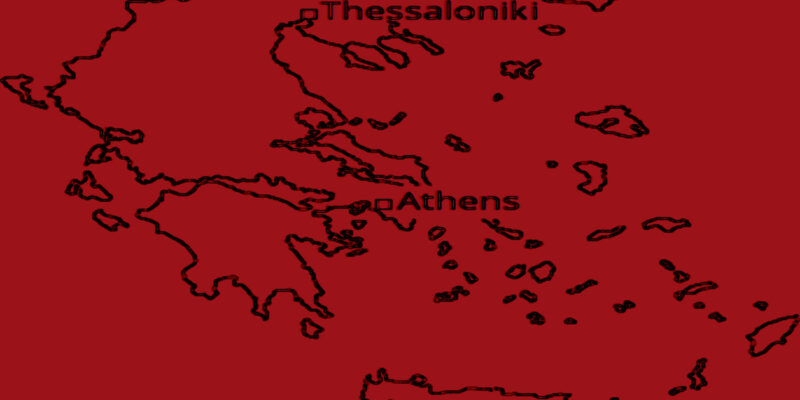Dimitris Troaditis. “Stelios Arvanitakis and the Communist Union of Greece”

Dimitris Troaditis. “Stelios Arvanitakis and the Communist Union of Greece”
During the 5th Extraordinary Electoral Congress of Sosialist Workers’ Party of Greece (SEKE – which under the bolshevization became Communist Party of Greece – KKE – in 1924) in October 1920, the Branch of Kavala (a town in northern Greece) and lots of members of the Branches of Athens, Piraeus and Patras, with Stelios Arvanitakis and Evangelos Papanastasiou as their main representatives, strongly opposed the participation of the Party in the elections, maintaining that the abstention from the elections should be also accompanied by revolutionary propaganda. However, the proposal of the leadership predominated and since then those who disagreed constituted the left wing of the Party and published separately the magazine “Kommounismos” (“Communism”).
On 9 April 1924, members of KKE from the Branches of Piraeus, Patras, Athens, Thessalonica, Syros, Karditsa and Volos, who had left or been expelled for mainly ideological reasons by the Party constituted the Kommounistiki Enosis Ellados (KEE – Communist Union of Greece) which published the magazine “Kommounistiko Vema” (“Communist Tribunal”). The most active Branch of this organisation was this of Piraeus.
“Leaders” of the KEE were Stelios Arvanitakis and the lawyer Evangelos Papanastasiou, who were came out to stand against the sosial-democratic elements tended to dominate KKE.
It is historically documented that Stelios Arvanitakis was an anarchist communist and Evangelos Papanastasiou believed in a wide spectrum of anarchist and libertarian ideas. Because of these they became the first target by the KKE which characterised them simply as “adventurers”.
However, it appears that KEE didn’t do a lot of things, mainly because of two reasons: a) the very polarised political climate with the arrival of the Pangkalos dictatorship and b) the slanderous war that SEKE (shorthly later KKE) started against the organisation. After one year of existence, the organisation was not working well and in February-March 1925 dissolved by the continuous attacks by the dictatorship.
The majority of their members returned to KKE, something that Stelios Arvanitakis, Evangelos Papanastasiou and a few others denied to do, while there was a small number of members withdrawn from the political life and action.
But, after a year, in 1926, KEE. re-founded and published the magazine “Mpolsevikiki Epitheorisi” (“Bolshevic Review”), adopting this time a more bolshevic rather an anarchist or libertarian orientation. Stelios Arvanitakis and Evangelos Papanastasiou with a few others opposed this orientation but accused by the new leadership of the organisation as anarho-extremists and they were expelled.
KEE, despite that it had roughly 250 members in country scale, it maintained its offices in Piraeus where an educative department was established and courses of Political Economy and Marxism delivered.
Apart Stelios Arvanitakis and Evangelos Papanastasiou, there were other known active militants in the organisation such as Kostas Vafeiadis, who was originated and educated in Russia and published many articles, Nikos Marakis, from Piraeus, linguist and intellectual, and Chrysanthos Karamouzis, from Chalkid, a Law student and later a journalist and theatrical writer.
Lawyer Evangelos Papanastasiou was also from Chalkida but he was living in Piraeus. Initially, while he was still member of SEKE, he was propagandising the principles of the 3rd International. He wrote and published the book “I Kommouna tou Parisiou” (“The Paris Commune”) and another one about the Balkans in relation of the then Oriental Question. According to the historian P. Noutsos, after his expulsion from KEE Papanastasiou abstained from the political action.
Regarding Stelios Arvanitakis, we must note that in 1920 he was sent by the Party (SEKE) in Patras, in order to prepare the constitution of a local Branch, but the police was always after him and he was arrested on 4 April 1920. In July of the same year, Arvanitakis stood in a trial in the Military Court of Patras, but finally acquitted. The SEKE Branch in this city was finally founded. Later, Stelios Arvanitakis was amongst those members of KEE who with its dissolution in 1925 did not return in the KKE. As we said before, it is historically documented that Stelios Arvanitakis was an anarchist communist, but still up today we have not managed to find any further available historical elements for this militant.
Agis Stinas and more recently Yannis Tamtakos (both old trotskyists who gradually after the war and civil war in Greece tended to anarchism) reported that Stelios Arvanitakis assassinated, amongst others dissidents (mainly trotskyists and left communists) by the paid murderers of OPLA (the stalinist militia during the German occupation).
Left historians such as Aggelos Elefantis and Kostis Moskoff, ignore completely KEE, trotskyist historian (and closed friend of Pablo) Dimitris Livieratos has characterised Stelios Arvanitakis and Evangelos Papanastasiou as extremists, while a group of other historians around KKE (Alekos Koutsoukalis and Katsoulis) as well one of the most prolific working class historians once general secretary of SEKE and later trotskyist Gianis Kordatos, has characterised them as ultra-revolutionaries and infantile left-wing elements (!).
*Firstly published in English here in http://www.anarkismo.net/article/9323


